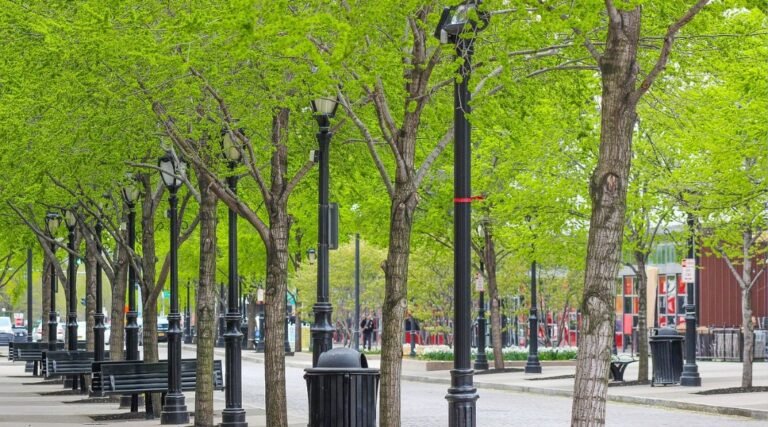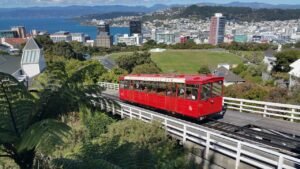
Keep Cool and Green: How Urban Trees Can Beat the Heat
During the very hot summer days, it is hard to find somewhere to escape the heat. Nonetheless, did you know that nature itself has cooling system? Trees Besides providing some shade that we need badly during such seasons, these towering plants also help in a big way to reduce temperatures.
This essay examines ways in which trees contribute towards cooling earth’s atmosphere while keeping her clean too. Trees function as a natural air conditioner by giving off water in a process known as transpiration; it is this evaporation that makes campuses, neighborhoods, and cities more livable by cooling the air within them.
Their shading effect helps reduce the amount of direct sunlight which tends to raise ground temperatures around them too much; thus greatly enhancing general experience of comfort within such environments. Through their canopies, they also prevent rapid loss of rainwater through evaporation by acting like natural umbrellas thus maintaining ground moisture.
Trees deliver instant benefits, but in addition they add to long term cooling. By abating carbon dioxide levels and soaking up air pollutants, trees aid in the fight against urban heat island effect where cities are much hotter due to concrete and asphalt. Birds and other wildlife find shelters in them which add to biodiversity.
The Role of Urban Trees in Cooling Urban Areas
Strategic planting of trees is among the best ways of fighting urban heat. Trees provide a natural solution to lower temperatures in cities by giving shade, losing moisture through transpiration while creating cooler environments.
They act as shields against the sun’s rays since branches form a canopy that limits direct sunlight on the earth surface hence reduces temperatures on it.
The cooling extended effect does not only apply in trees immediate areas, it has a widespread pronouncedness from one aforentioned town all the way to other neighborhoods within the cities. Therefore, cities may benefit from enhanced heat resistance capacities during summer periods through allowing trees to grow all over while giving their residents happier moments.
How urban Trees Reduce the Urban Heat Island Effect
One of the mechanisms where people and their infrastructures generate heat is balanced by trees thus lessening the hot city towns.
Trees discharge vapor in the air by transpiration which cools down the surrounding. As a result, this helps in preventing global temperatures rise due to buildings and roads absorbing too much heat. Trees also absorb other chemical compounds such as carbon dioxide but also any of the air pollutants improving the air quality and in addition further lessening the heat trapping effects of pollution.
To effectively fight against the urban heat island effect as well as building a more sustainable and habitable environment cities should strategically plant and grow trees within metropolitans.
The Science behind Tree Cooling Mechanisms
Trees act as coolers due to the fact that they give shades meaning that it is not a simple thing. This function relies more on different scientific principles controlling the temperatures as well as moisture amount.
In forest ecology transpiration which involves release of liquid into the atmosphere by trees’ leaves forms the most fundamental component of such systems. Evaporation of water at cell surface absorbs heat from air thereby leading to cooling both tree itself and its immediate surrounding communities.
The shade protects against heat by trees provides ample room for excessive sweat transpiration. Furthermore, trees’ present cause breezy conditions leading to convection currents that disperse warmth thus cooling air around them. In order to fully utilize the tree benefits for reducing heat in cities, it is crucial to understand how they cool themselves.
Choosing the Right Tree Species for Heat Mitigation
Trees that drop their leaves every winter are the most advisable in city high temperatures control since they allow shed the shade during summertime and remain let sunlight pass through during the winter; Concern the following factors for selecting trees which are good in mitigating Temperature such as canopy density, leaf size, and water necessities.
Different tree species vary greatly in their cooling properties within the city. When sunlight is blocked out and surface temperature drops, trees that cover their large areas with dense spread branches help. Suitable tree species for cities experiencing heat can make it cool through having as many urban trees as possible that take up less water hence making such places sustainable forests economically.
It is important to use tree species which are able to survive without receiving too frequent watering during dry periods.
The Benefits of Urban Trees Canopies
The urban trees canopies beyond cooling urban areas have various other benefits. Providing habitat and food for birds, insects and other wildlife, bring about supporting biodiversity in cities and enhancing the urban ecosystem. In addition, tree canopies also aid in preventing flooding and erosion by absorbing rainwater and delaying its runoff to some extent.
Apart from that they add a certain aesthetic value to the city because they help in setting up parks while enhancing the lives of people living there. There is a myriad of health benefits that are associated with the existence of tree canopies; these include stress reduction, better air quality and increased physical activity.
If cities decide to put money into as well as conserve their green zones, they will benefit from a wide range of social environmental, and economical advantages that will boost the general health of their inhabitants.
Strategies for Incorporating Trees into Urban Planning and Design
Urban trees should be integrated with planning and design policy in order to increase the benefits they can provide for heat moderation and contemporary environmental concerns. There are many different tactics through which towns can identify space within limits for trees to include road verges, sky gardens as well as walls with plants on them but urban parks or woodlands should be established at most cases.
In addition to that, they are significant in making air clean while reducing the noise level, apart from provision of shades which aid in temperature regulation. Green roofs and walls can reduce energy consumption, insulate buildings, and be ideal habitats for plants and animals. Urban parks and forests offer leisure opportunities to the communities, promote neighborhood involvement, and improve the general quality of life in urban centers.
When it comes to urban greening, cities may establish more environmentally friendly and enduring urban environments that are beneficial to both mankind and the earth.
Tree Care and Maintenance for Heat Resilience
The key to retaining the long-term existence and condition of trees within the cities is to make them most advantageous for temperature decrease and clean surround safety.
It is water, mulch and tidying that are essential in trees maintenance since they help them to stay in the city among such problems as soil compaction, pollution and lack of space in a city. Hence trees care particularly pruning, watering mulching among other activities help in keeping the trees healthy and recovering.
One way to make sure that pests do not damage the health of trees is by keeping an eye on how well they are doing and taking care of any issues immediately. Involving the society in taking care of trees can make them love and respect these important elements of nature.
To ensure that their urban trees remain cool and contribute to the general meaning, towns should put their money into taking care of the trees.
Case Studies of Successful Tree-Based Heat Mitigation Projects
There are many cities across the globe with tree-based strategies which have shown how effective they can be when it comes to reducing temperatures. For instance Melbourne Australia invested in urban forestry plan whose primary objective was to enhance tree canopy coverage and also enhance quality of parks within the city.
Melbourne has significantly reduced temperatures in urban areas by planting a diverse range of tree species and incorporating green infrastructure, resulting in improved air quality and more livable neighborhoods. Portland, Oregon, on the other hand, also has implemented a street tree planting program to help reduce energy consumption, mitigate the urban heat island effect, and enhance the urban environment.
So, Urban heat and Climate Change are enemies that trees are waging war against so powerfully. This therefore makes them greatly needed since they are capable of cooling down these cities minimizing air pollution among other benefits to wildlife as well as human beings.
And so natural way of incorporating them is into the planning and design of cities, selecting the correct types for cooling down with respect heat mitigation as well as spending some money on them for care. This is how city governments could benefit from trees.
In the face of a warming world, urban trees provide a nature-based solution that benefits us and environment. So, let’s remain cool and green by embracing these unnamed heroes working tirelessly to ensure our comfort and safety.
Together, we can create a more sustainable, resilient urban environment that is cooler, greener, and healthier for all. Let’s plant more urban trees so that future generations will live in cities that seamlessly blend with nature.




